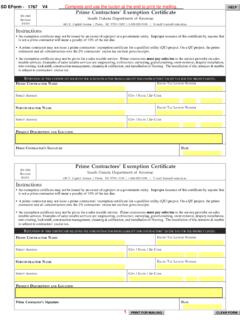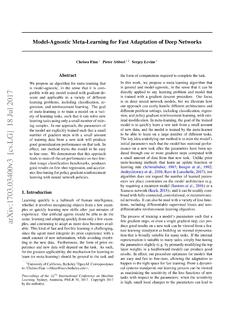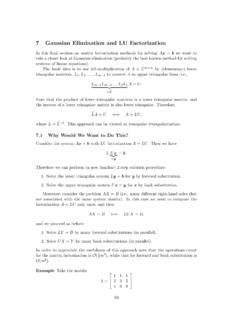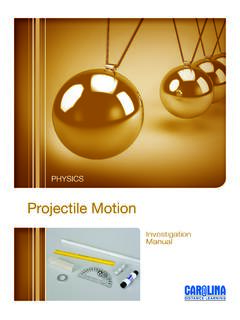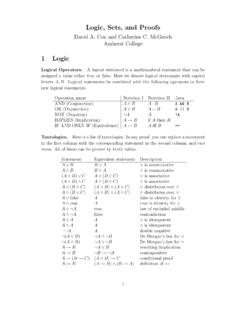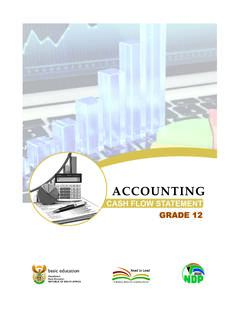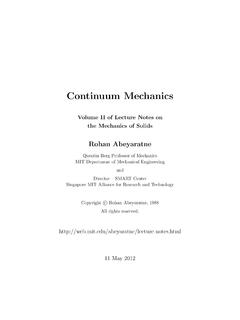Transcription of Multivariable Calculus - Mississippi State University
1 Multivariable CalculusSeongjai KimDepartment of Mathematics and StatisticsMississippi State UniversityMississippi State , MS 39762 USAE mail: March 8, 2022 Seongjai Kim, Professor of Mathematics, Department of Mathematics and Statistics, MississippiState University , Mississippi State , MS 39762 USA. Email: lecture note is closely following the part of Multivariable Calculus inStewart s book[7]. Inorganizing this lecture note, I am indebted byCedar Crest College Calculus IV Lecture Notes, Hammer [1].Two projects are included for students to experiencecomputer algebra. Computer algebra(also calledsymbolic computation) is a scientific area that refers to the study and developmentof algorithms and software for manipulating mathematical expressions and other mathematical ob-jects; it emphasizesexact computationwith expressions containing variables that have no givenvalue and are manipulated as symbols.
2 In practice, you can use computer algebra to effectively han-dle complex math equations and problems that would be simply too complicated/time-consuming todo by hand. The projects are organized the lecture note, I tried to make figures using Maple. Also added are some of program-ming scripts written in Maple. The end of each section includes exercise problems. For problemsindicated by theComputer Algebra System(CAS) signCAS, you are recommended to use a CAS tosolve the the lecture note is not fully grown up; other useful techniques and interesting exam-ples would be soon incorporated. Any questions, suggestions, comments will be deeply KimAugust 16, 2019iiiivContentsTitleiiPrologueiiiTable of Contentsvii12 Vectors and the Geometry of Operations .. 3D coordinate systems .. Vectors and vector operations .. in the 3D Space .. and Quadric Surfaces .. 1414 Partial of Several Variables.
3 Domain and range .. Graphs .. Level curves .. Functions of three or more variables .. and Continuity .. Derivatives .. First-order partial derivatives .. Higher-order partial derivatives .. Planes & Linear Approximations .. Chain Rule .. Chain rule .. Implicit differentiation .. Derivatives and the Gradient Vector .. and Minimum Values .. Local extrema .. Absolute extrema .. Multipliers .. Problems for Ch. 14 .. Linear and Quadratic Approximations .. Newton s method .. Estimation of critical points .. Quadratic approximations .. 7715 Multiple Integrals over Rectangles .. Volumes as double integrals .. Iterated integrals .. Integrals over General Regions .. Integrals in Polar Coordinates .. of Double Integrals .. Area.
4 Integrals .. Integrals in Cylindrical Coordinates .. Integrals in Spherical Coordinates .. of Variables in Multiple Integrals .. Problems for Ch. 15 .. The Volume of the Unit Ball inn-Dimensions .. 14216 Vector Fields .. Definitions .. Gradient fields and potential functions .. Integrals .. Line integrals for scalar functions in the plane .. Line integrals in space .. Line integrals of vector fields .. Fundamental Theorem for Line Integrals .. Conservative vector fields .. Independence of path .. Potential functions .. s Theorem .. Application to area computation .. Generalization of Green s Theorem .. and Divergence .. Curl .. Divergence .. Vector forms of Green s Theorem .. Surfaces and Their Areas .. Parametric surfaces .. Tangent planes .. Surface area .. Integrals.
5 Surface integrals of scalar functions .. Surface integrals of vector fields .. s Theorem .. Divergence Theorem .. The Area of Heart .. Problems for Ch. 16 .. Formulas for Chapter 16 .. 23617 Optimization Calculus : Euler-Lagrange Equations .. Total variation .. Calculus of variation .. Descent Method .. The gradient descent method in 1D .. Examples .. The choice of step length and line search .. Optimizing optimization .. 254A Review for 12 Selected ( ) Tangent Planes and Linear Approximations .. ( ) Directional Derivatives and Gradient Vector .. ( ) Lagrange Multipliers .. ( ) Double Integrals over General Regions .. ( ) Triple Integrals in Cylindrical Coordinates .. ( ) Change of Variables in Multiple Integrals .. ( ) Line Integrals .. ( ) The Fundamental Theorem for Line Integrals.
6 ( ) Green s Theorem .. ( ) Surface Integrals .. ( ) Stokes s Theorem .. ( ) The Divergence Theorem .. 281 Bibliography283 Index285viiiContentsChapter 12 Vectors and the Geometry of SpaceIn this chapter, we study vectors and equations in the 3-dimensional (3D)space. In particular, you will learn vectors dot product cross product equations of lines and planes, and cylinders and quadric surfacesContents of Chapter Operations .. in the 3D Space .. and Quadric Surfaces .. 14 This chapter corresponds to Chapter 12 in STEWART, Calculus (8th Ed.), 12. Vectors and the Geometry of Vector OperationsThere exists a lot to cover in the class of Multivariable Calculus ; however, itis important to have a good foundation before we trudge forward. In thatvein, let s review vectors and their geometry in space (R3) 3D coordinate systemsRecall: LetP= (x1,y1)andQ= (x2,y2)be points inR2.
7 Then thedis-tancefromPtoQis|PQ|= (x2 x1)2+ (y2 y1)2.( ) (x1,y1,z1)andQ= (x2,y2,z2)be points thedistancefromPtoQis|PQ|= (x2 x1)2+ (y2 y1)2+ (z2 z1)2.( ) ( 3, 2, 7)andQ( 1, 0, 6). : Vector Operations3 Recall: AcircleinR2is defined to be all of the points in the plane (R2)that are equidistant from a central pointC(a,b).(x a)2+ (y b)2=r2.( )A natural generalization of this to 3-D space would be to say that asphere is defined to be all of the points inR3that are equidistant from acentral pointC. This is exactly what the following definition does! (h,k,l)be a point inR3. Then thespherecen-tered atCwith radiusris defined by the equation(x h)2+ (y k)2+ (z l)2=r2.( )That is to say that this defines all points(x,y,z) R3that are at thesame distancerfrom the centerC(h,k,l). thatx2+y2+z2 4x+ 2y 6z+ 10 = 0is the equationof a sphere, and find its center and :C(2, 1, 3)andr= 24 Chapter 12.
8 Vectors and the Geometry of Vectors and vector a mathematical object that stores bothlength (which we will often call magnitude) and (x1,y1,z1)andQ= (x2,y2,z2). Then thevectorwith initial pointPand terminal pointQ(denoted PQ) is defined by PQ= x2 x1,y2 y1,z2 z1 = OQ OP,whereOis the origin,O= (0, 0, 0). The vector OPis called thepositionvectorof the pointP. For convenience, we use bold-faced lower-case lettersto denote vectors. For example,v=<v1,v2,v3>is a (position) vector inR3associated with the point(v1,v2,v3). vectors are said to beequalif and only if theyhave the same length and direction, regardless of their position is to say that a vector can be moved (with no change) anywhere inspace as long as the magnitude and direction are <v1,v2,v3>. Then themagnitude( ) ofv(denoted|v|or sometimes||v||) is defined by|v|= v21+v22+v23.( ) (Vector addition) Letu=<u1,u2,u3>andv=<v1,v2,v3>.
9 Thenu+v=<u1+v1,u2+v2,u3+v3>. Vector (Scalar multiplication) Letv=<v1,v2,v3>andk <kv1,kv2,kv3>. <0, 3, 4>andb=<1, 5, 2>, find|a|,2a 3b, and|2a 3b|. :|a|= 5;2a 3b=< 3, 9, 2>;|2a 3b|= vectoris a vector whose magnitude is that given a vectorv, we can form a unit vector (of the same direc-tion) by dividing by its magnitude. That is, letv=<v1,v2,v3>. Thenu=v|v|( )is a unit vector in the direction vector can be denoted as the linear combinationof thestandard unit vectorsi=<1, 0, 0>,j=<0, 1, 0>,k=<0, 0, 1>.So given a vectorv=<v1,v2,v3>, one can express it with respect to thestandard unit vectors asv=<v1,v2,v3>=v1i+v2j+v3k.( )This text, however, will more often than not use the angle brace 12. Vectors and the Geometry of <u1,u2,u3>andv=<v1,v2,v3>. Then thedot productisu v=u1v1+u2v2+u3v3,( )which is sometimes referred as theEuclidean inner product. Notethatv v=|v| be the angle betweenuandv(so0 ).
10 Thenu v=|u||v|cos( ).( ) vectorsuandvare orthogonal if and only ifu v= the angle between the vectorsa=<2, 2, 1>andb=<3, 0, 3>. : /4 (= 45 ) Vector <u1,u2,u3>andv=<v1,v2,v3>. Then thecross productis the determinant of the following matrix:u v=det i j ku1u2u3v1v2v3 =det[u2u3v2v3]i det[u1u3v1v3]j+det[u1u2v1v2]k=<u2v3 u3v2,u3v1 u1v3,u1v2 u2v1>.( ) the cross producta b, whena=<1, 3, 4>andb=<3, 1, 2>. :< 2, 14, 10> vectora bis orthogonal to be the angle betweenaandb(so0 ).Then|a b|=|a||b|sin( ).( )8 Chapter 12. Vectors and the Geometry of length of the cross producta bis equal to the areaof the parallelogram determined that two nonzero vectorsaandbare parallel if andonly ifa b= : Finding the direction of thecross product by the right-hand cross producta bis defined asa vector that is perpendicular (or-thogonal) to bothaandb, with adirection given by theright-handruleand a magnitude equal to thearea of the parallelogram that thevectors the fingers of your right handcurl in the direction of a rotation(through an angle less than180 )fromatob, then the thumb pointsin the direction ofa b.

